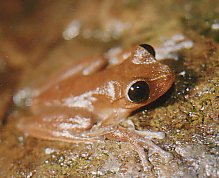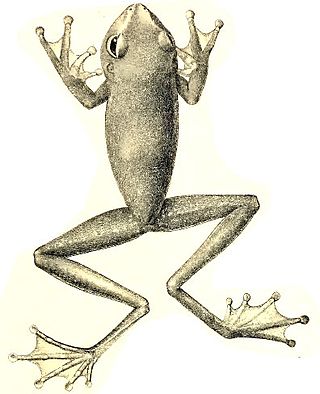
Nyctimystes is a genus of tree frogs in the subfamily Pelodryadinae of the family Hylidae. They are principally Papuan species, but also inhabit islands in the Moluccas. All species in this genus have one distinct feature that separates them from other species in the family, the lower eyelid is marked with pattern of lines, veins, or dots. This feature presumably acts as camouflage when the frogs are at rest during the day.
Nyctimystes avocalis is a species of frog in the subfamily Pelodryadinae. It is endemic to Papua New Guinea and is only known from its type locality on the east slope of Goodenough Island, one of the D'Entrecasteaux Islands. It has been given the common name loud big-eyed treefrog.
Nyctimystes daymani, also known as the Dayman big-eyed treefrog, is a species of frog in the subfamily Pelodryadinae. It is endemic to Papua New Guinea and known from its type locality, Mount Dayman in the Milne Bay Province, easternmost mainland New Guinea. Records from further west are uncertain.
Nyctimystes fluviatilis, also known as the Indonesian big-eyed tree frog, is a species of frog in the subfamily Pelodryadinae of the family Hylidae. It is endemic to New Guinea and is known from Idenburg River and Wapoga River in Papua province, Indonesia, and from the Torricelli Mountains in the East Sepik Province and Kavorabip in the Western Province, both in the western Papua New Guinea.
Nyctimystes gularis, the Mondo big-eyed tree frog, is a species of frog in the subfamily Pelodryadinae, endemic to Papua New Guinea. Its natural habitats are subtropical or tropical moist montane forests and rivers.
Nyctimystes kubori is a species of frog in the subfamily Pelodryadinae of the family Hylidae. It is endemic to Papua New Guinea and is widespread in the New Guinea Highlands between 141°E and 147°E and in the mountains of the Huon Peninsula. The specific name kubori refers to its type locality in the Kubor Mountains. Common name sandy big-eyed treefrog has been coined for this species.

Nyctimystes montanus is a species of frog in the subfamily Pelodryadinae. It is endemic to the Arfak Mountains, located in the Bird's Head Peninsula of northwestern New Guinea. This species is only known from its type locality. There are no records of this species after it was described in 1878, perhaps because of lack of surveys.
Nyctimystes narinosus, the common big-eyed treefrog, is a species of frog in the subfamily Pelodryadinae of the family Hylidae. It is endemic to New Guinea and occurs in the Wahgi-Sepik Dividing Range and the Schrader Mountains, on both sides of the border between Papua (Indonesia) and Papua New Guinea. There is, however, some uncertainty about the western limit of this species. Despite its vernacular name, Nyctimystes narinosus is not a common species.
Nyctimystes persimilis, also known as the Milne big-eyed treefrog, is a species of frog in the subfamily Pelodryadinae of the family Hylidae. It is endemic to Papua New Guinea and known from Mount Dayman and Mount Simpson in the Owen Stanley Range.
Nyctimystes trachydermis, also known as the Morobe big-eyed treefrog, is a species of frog in the subfamily Pelodryadinae of the family Hylidae. It is endemic to Papua New Guinea and occurs in the mountains of southern eastern New Guinea. Its type locality is Gapaia Creek, at 1,280 m (4,200 ft) asl between Garaina and Saureli, in the Morobe Province. The specific name trachydermis means "rough skinned", derived from the Greek words trachys and derma.
Nyctimystes tyleri is a species of frog in the subfamily Pelodryadinae of the family Hylidae. It is endemic to Papua New Guinea and only known from its type locality, Gapaia Creek, between Garaina and Saureli, in the Morobe Province. The specific name honours Michael J. Tyler, an Australian herpetologist, "in recognition of his notable contributions to the systematics of Australo-papuan frogs." Common name Tyler's big-eyed treefrog has been coined for this species.
Atlantihyla panchoi, also known as the Guatemala stream frog, is a species of frog in the family Hylidae. It is endemic to eastern Guatemala and is only known from three localities in the Sierra de las Minas and Montañas del Mico ranges. The specific name panchoi honors Laurence Cooper "Don Pancho" Stuart, an American herpetologist.
Austrochaperina basipalmata is a species of frog in the family Microhylidae. It is endemic to the mountain ranges of northern New Guinea and is found between Tawarin River in Papua, Western New Guinea (Indonesia) and Torricelli Mountains in Papua New Guinea.

Cophixalus pipilans is a species of frog in the family Microhylidae. It is endemic to northern mainland Papua New Guinea and occurs between Lae and the Adelbert Mountains. The specific name pipilans is derived from the Latin verb pipilio and means "peeping". Common name Sempi rainforest frog has been coined for this species.
Cophixalus riparius is a species of frog in the family Microhylidae. It is endemic to Papua New Guinea and occurs in the New Guinea Highlands in Madang, Southern Highlands, and Western Highlands provinces southeastward to the Morobe Province. The specific name riparius refers to the creek-side habitat from which many specimens in the type series were collected. Common name Wilhelm rainforest frog has been coined for this species.
Cophixalus tagulensis is a species of frog in the family Microhylidae. It is endemic to Papua New Guinea and only known from the Tagula Island in the Louisiade Archipelago, east of New Guinea. It is only known from the type series of three specimens collected in 1956.
Cornufer gilliardi, commonly known as Gilliard's wrinkled ground frog, is a species of frog in the family Ceratobatrachidae. It is endemic to the Whiteman Ranges of New Britain, Bismarck Archipelago. The specific name gilliardi honors Ernest Thomas Gilliard, an American ornithologist who, together with Margaret Gilliard, collected the holotype.
Cornufer punctatus, commonly known as the dotted wrinkled ground frog, is a species of frog in the family Ceratobatrachidae. It is endemic to Western New Guinea (Indonesia) and occurs in the Arfak and Wondiwoi Mountains on the New Guinea mainland well as on some adjacent islands.
Papurana milneana is a species of "true frog", family Ranidae. It is endemic to Papua New Guinea where it is found in the upland areas of Milne Bay, Morobe, Northern, and Central Provinces, as well from the D'Entrecasteaux Islands and, tentatively, Louisiade Archipelago. It was originally described as a subspecies of Rana grisea, but raised to full-species status in 2007.
Papurana supragrisea is a species of true frog, family Ranidae. It is endemic to New Guinea, including some nearby islands. It is known with certainty only from southeastern New Guinea and from the D'Entrecasteaux Islands. However, this name has been used more broadly for a species complex that is widely distributed in the mountains of New Guinea. Common name Papua gray frog has been coined for it.



